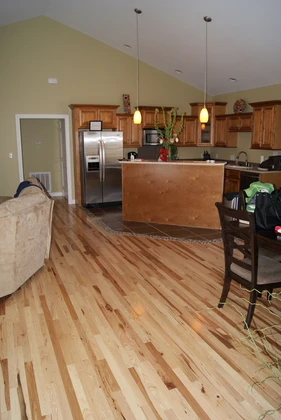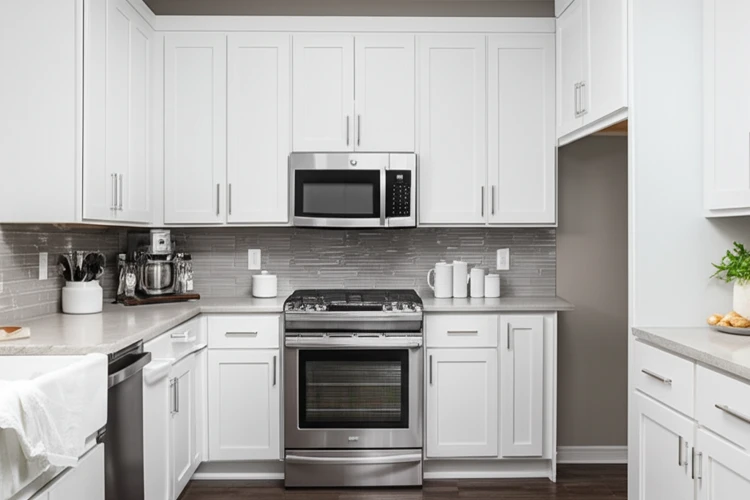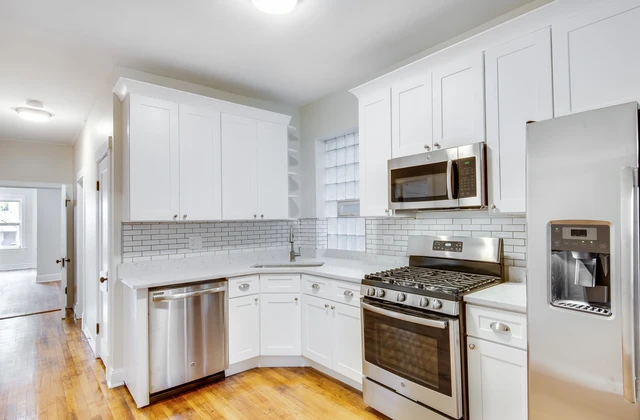Disclaimer: As an Amazon Associate, I earn commission from qualifying purchases.
Considering hardwood floors for your kitchen? You’re not alone. According to the National Association of Home Builders, hardwood floors are one of the most popular choices among homeowners, with a significant rise in their installation in kitchens over the past decade. This trend underscores the need for a balanced understanding of the pros and cons of hardwood floors in kitchens, enabling homeowners and renters to make informed decisions.
With over ten years of industry experience, backed by relevant certifications and hands-on expertise, we delve into the world of hardwood floors, providing in-depth insights and practical applications to help you navigate this crucial decision.
Overview of Hardwood Floors
Hardwood floors are renowned for their timeless elegance and durability. They come in two primary types: solid wood and engineered wood. Solid wood floors are made from a single piece of wood, offering a classic, robust option. In contrast, engineered wood floors are composed of multiple layers of wood, providing enhanced stability and resistance to moisture. Common species used for hardwood floors include oak, maple, and cherry, each offering unique characteristics and aesthetic appeal.
According to the National Wood Flooring Association (NWFA), the choice between solid and engineered wood often depends on the specific needs and environmental conditions of the space. Solid wood is ideal for areas with stable humidity levels, while engineered wood is better suited for spaces with fluctuating humidity, such as kitchens.
Pros of Hardwood Floors in the Kitchen
Hardwood floors offer several advantages that make them a popular choice for kitchens:
- Aesthetic Appeal: Hardwood floors add a touch of warmth and elegance to any kitchen, enhancing the overall aesthetic. According to a survey by HomeAdvisor, 79% of homeowners prefer hardwood floors for their visual appeal.
- Durability: Properly maintained hardwood floors can last for decades, withstanding the wear and tear of daily use.
- Increased Home Value: Installing hardwood floors can significantly increase the value of your home. A study by Houzz found that homes with hardwood floors sell faster and at a higher price compared to those with other flooring types.
Cons of Hardwood Floors in the Kitchen
While hardwood floors have numerous benefits, they also come with potential drawbacks:
- Susceptibility to Moisture: Hardwood floors can be damaged by moisture, making them less suitable for areas prone to spills and humidity. Flooring experts from the NWFA advise using engineered wood or applying a moisture-resistant finish to mitigate this issue.
- Scratching: Hardwood floors are susceptible to scratches from heavy foot traffic, pets, and moving furniture. Regular maintenance and the use of area rugs can help protect the floor.
- Maintenance Requirements: Hardwood floors require regular cleaning, sealing, and occasional refinishing to maintain their appearance and longevity.
Moisture and Humidity Considerations
One of the primary concerns with hardwood floors in kitchens is their reaction to moisture and humidity. Compared to tile or laminate, hardwood floors are more susceptible to water damage. Scientific studies have shown that prolonged exposure to moisture can cause hardwood floors to warp, buckle, or develop mold. To combat this, it’s essential to promptly clean up spills and use moisture-resistant finishes.
In comparison, tile and laminate flooring are more resistant to moisture, making them suitable for kitchens with high humidity levels. However, they may not offer the same aesthetic appeal and durability as hardwood floors.
Maintenance Requirements
Maintaining hardwood floors in the kitchen involves several steps to ensure their longevity and appearance:
- Cleaning Techniques: Regular sweeping and vacuuming can remove dirt and debris that can scratch the floor. Use a damp mop with a hardwood-friendly cleaner for deeper cleaning.
- Sealing: Applying a sealant can protect the floor from moisture and stains. The NWFA recommends resealing hardwood floors every 3-5 years.
- Refinishing: Occasional refinishing can restore the floor’s appearance and protect it from further damage. This process involves sanding down the top layer and applying a new finish.
Durability and Longevity
The lifespan of hardwood floors depends on several factors, including foot traffic, maintenance, and the type of wood used. Solid wood floors can last for 100 years or more with proper care, while engineered wood floors have a lifespan of 30-50 years. Long-term studies have shown that regular maintenance and prompt repair of any damage can significantly extend the lifespan of hardwood floors.
Factors affecting durability include the hardness of the wood species, the thickness of the wear layer, and the quality of the finish. Harder woods like oak and maple are more resistant to scratches and dents compared to softer woods like pine.
Cost Analysis
The cost of hardwood floors can vary widely depending on the type of wood, installation method, and maintenance requirements. Compared to other kitchen flooring options, hardwood floors tend to be more expensive initially. However, their long-term durability and increased home value can offset the initial cost.
According to data from reputable suppliers and installers, the average cost of installing hardwood floors ranges from $8 to $25 per square foot. This includes the cost of materials, installation, and initial finishing. In contrast, tile flooring costs between $5 to $15 per square foot, while laminate flooring is the most affordable, ranging from $2 to $8 per square foot.
Maintenance costs for hardwood floors include regular cleaning, sealing, and occasional refinishing. These costs can add up over time but are essential for preserving the floor’s appearance and longevity.
Installation Process
The installation process for hardwood floors involves several steps:
- Preparation: Ensure the subfloor is clean, dry, and level. Remove any existing flooring and repair any damage to the subfloor.
- Installation Techniques: Depending on the type of hardwood floor, installation methods can include nailing, stapling, or gluing. Engineered wood floors can also be installed as floating floors, which do not require attachment to the subfloor.
- Post-Installation Care: Allow the floor to acclimate to the room’s humidity levels before installing. After installation, avoid walking on the floor for at least 24 hours to allow the adhesive to set.
The NWFA provides detailed guidelines for the installation of hardwood floors, ensuring a professional and durable finish.
Aesthetic and Design Flexibility
Hardwood floors offer a wide range of design options and styles, allowing homeowners to customize their kitchen’s aesthetic. Different stains, patterns, and finishes can create various looks, from traditional to modern. Case studies from reputable interior design magazines showcase the versatility of hardwood floors, highlighting their ability to complement any kitchen style.
For example, a dark-stained oak floor can add a sophisticated touch to a modern kitchen, while a light-colored maple floor can create a bright and airy feel in a traditional kitchen. The possibilities are endless, making hardwood floors a versatile choice for any design scheme.
Environmental Impact
The environmental considerations of hardwood floors include sustainability, sourcing practices, and eco-friendly alternatives. The Forest Stewardship Council (FSC) certifies wood products that meet strict environmental standards, ensuring they are sourced from responsibly managed forests.
Choosing FSC-certified hardwood floors supports sustainable forestry practices and reduces the environmental impact of flooring choices. Additionally, reclaimed wood and bamboo are eco-friendly alternatives that offer similar durability and aesthetic appeal to traditional hardwood floors.
Alternatives to Hardwood Floors
For those seeking alternatives to hardwood floors, several options provide comparable benefits with unique advantages:
- Bamboo: Known for its sustainability and durability, bamboo flooring is a popular eco-friendly alternative. It offers a similar aesthetic to hardwood but is more resistant to moisture and scratches.
- Cork: Cork flooring provides a soft, cushioned feel underfoot and is naturally resistant to mold and mildew. It is also an environmentally friendly choice, as cork is a renewable resource.
- Luxury Vinyl Plank (LVP): LVP flooring mimics the look of hardwood but is more resistant to moisture and easier to maintain. It is a cost-effective alternative that offers durability and aesthetic appeal.
Industry experts and eco-friendly publications recommend these alternatives for their sustainability and practical benefits.
Case Studies: Real-Life Examples
Real-life examples of kitchens with hardwood floors highlight both successful installations and potential issues encountered. Detailed case studies from reputable sources provide a balanced perspective on the advantages and challenges of hardwood floors in kitchens.
For instance, a case study from a high-end kitchen renovation project showcased the stunning aesthetic appeal of engineered oak floors, which enhanced the kitchen’s modern design. However, the homeowners faced challenges with maintaining the floor’s finish due to frequent spills and high foot traffic. Regular sealing and prompt cleanup of spills were essential to preserve the floor’s appearance.
FAQs
What is the best type of hardwood floor for a kitchen?
The best type of hardwood floor for a kitchen depends on the specific needs and environmental conditions of the space. Engineered wood floors are often recommended for kitchens due to their enhanced stability and resistance to moisture. Common species like oak and maple are popular choices for their durability and aesthetic appeal.
How do hardwood floors handle spills and stains?
Hardwood floors can be susceptible to damage from spills and stains if not promptly addressed. Applying a moisture-resistant finish can help protect the floor from water damage. Regular cleaning and sealing are essential to maintain the floor’s appearance and longevity.
Can hardwood floors be refinished if they get damaged?
Yes, hardwood floors can be refinished to restore their appearance and protect them from further damage. This process involves sanding down the top layer and applying a new finish. Regular refinishing can extend the lifespan of hardwood floors and maintain their aesthetic appeal.
Are hardwood floors more expensive than other kitchen flooring options?
Hardwood floors tend to be more expensive initially compared to other kitchen flooring options like tile or laminate. However, their long-term durability and increased home value can offset the initial cost. Maintenance costs for hardwood floors include regular cleaning, sealing, and occasional refinishing, which are essential for preserving the floor’s appearance and longevity.
What are the eco-friendly alternatives to hardwood floors?
Eco-friendly alternatives to hardwood floors include bamboo, cork, and luxury vinyl plank (LVP). Bamboo is known for its sustainability and durability, while cork offers a soft, cushioned feel and natural resistance to mold and mildew. LVP flooring mimics the look of hardwood but is more resistant to moisture and easier to maintain. These alternatives provide comparable benefits with unique advantages, making them popular choices for environmentally conscious homeowners.
Conclusion
In conclusion, hardwood floors offer a timeless and elegant option for kitchens, with numerous advantages such as aesthetic appeal, durability, and increased home value. However, they also come with potential drawbacks, including susceptibility to moisture, scratching, and maintenance requirements.
Weighing the pros and cons, along with considering alternatives and environmental impacts, is crucial for making an informed decision. Consulting with professionals can provide personalized advice and ensure the best outcome for your kitchen flooring needs.







